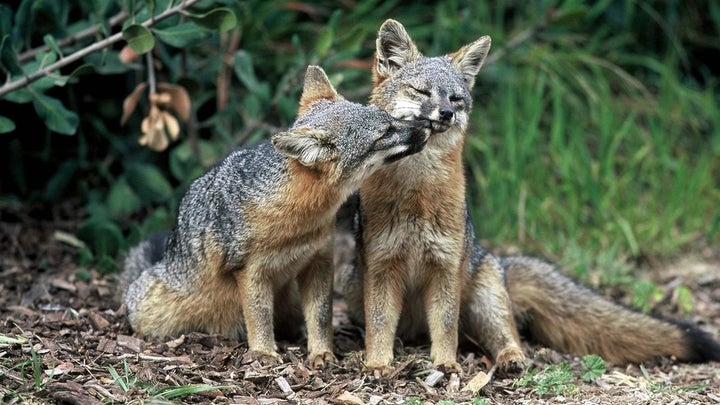
Island foxes are one of the few animals to be removed from the endangered species list. Critics say the low recovery rate under the law shows it needs to be changed.
A fight is brewing over the Endangered Species Act after congressional Republicans and federal agencies this year proposed major changes, including shifting more control over species protection to the states.
Many states, especially Western ones with vast expanses of federal land, have long pushed for changes to the law. But what seemed unlikely under prior administrations has a better shot under the Trump presidency.
A package of bills introduced in the U.S. House of Representatives by members of the Congressional Western Caucus, all with Republican sponsors, would alter how species are listed and habitat is protected. States are most focused on measures that would affect their power, including bills that would allow them greater say over which species get protections. A draft bill in the U.S. Senate being circulated by Wyoming Sen. John Barrasso, a Republican, would “elevate the role of state conservation agencies,” according to a news release from the U.S. Senate committee he chairs.
While the various pieces of legislation may face a heavy lift getting through Congress, federal agencies last month finished taking public comments on proposed rule changes. Unveiled in July, the agency revisions would allow agencies to consider economic costs when deciding whether to protect species, possibly reduce the amount of protected habitat and make it easier to take species off the endangered and threatened species list, among other changes proposed by the Department of the Interior and the National Oceanic and Atmospheric Administration.
A letter from Democratic attorneys general in nine left-leaning states and the District of Columbia opposed the agencies’ proposed changes, in part because they would “impose significantly increased costs and burdens on the states,” which would pick up the slack. The attorneys general also say the changes would weaken the law by constraining the government’s ability to consider climate change.
Endangered species protections have become a polarizing debate. Those who favor changing the law accuse environmentalists of using it to keep land locked away from ranchers or industry. Green groups argue that states eager to take on new roles want to limit federal interference with no real intention of maintaining protections.
But governors, industry and wildlife experts are sharply divided over whether states have the resources or legal framework in place to take on a greater workload.
“If the argument is that states will be better because they’re more efficient at managing endangered species protection, there is little evidence of that,” said Alejandro Camacho, a law professor at the University of California at Irvine who wrote a paper analyzing state spending and laws dealing with endangered species.
The federal law passed in 1973 precisely because states weren’t doing a sufficient job of protecting species, he said.
But policy advisors in states that want to take on a greater role in conservation say the federal government has a poor track record of recovering species once they are on the list. Just 53 species added to the list have been removed because their populations sufficiently rebounded.
Strapped States’ Shifting Role
The Endangered Species Act protects nearly 2,500 domestic and foreign animals and plants that are designated as threatened or endangered, according to the U.S. Fish and Wildlife Service. The law can be used to protect lands that are deemed critical habitat for those species.
States contribute to those efforts. Many state fish and wildlife departments have biologists that track animals and plants and collect data that contribute to decisions the federal government makes about what species are added to the list and what efforts can be made to strengthen their numbers.
But Camacho said state funding spent on conservation is far behind what the federal government spends — just 5 percent of total spending on species protection comes from states.
Of course, it’s common for state spending to pale in comparison with that of the federal government. But the legal framework in states, Camacho said, also is not as robust as the federal law.
While some states, such as Massachusetts, have a law that is more protective than the federal one, many don’t, and Wyoming and West Virginia have no state law to protect endangered species.
Unlike the federal law, Camacho said, many state laws don’t allow citizens to petition to protect a species or may not require the use of the best scientific evidence. Many have fewer restrictions on how private land can be used even if endangered species live there.
“If you change the federal law in ways that remove the federal government from regulatory implementation, then the state legal structure isn’t there to fill in the gaps,” he said, “and the state resources to fill in the gaps aren’t there either.”
But those advocating for a greater state role say studies like Camacho’s consider an extreme case where states would be almost entirely responsible for current federal roles.
John Swartout, who works as a senior policy advisor for Colorado Gov. John Hickenlooper, a Democrat, said state officials often feel their expertise on species — and their data in particular — isn’t valued.
“We want them to take our science seriously, because often it is the best science,” he said, “and we want to work in partnership with them.”
Some officials in New Mexico and Wyoming, however, have pushed for states to take on a far greater role if states are deemed “willing and able.”
“Our thought is it would be up to states to avail themselves of as much or little as is able to be delegated,” said Matthias Sayer, who has been developing a proposal for greater state involvement under New Mexico Gov. Susana Martinez, a Republican. The regulatory proposal has yet to be filed with the Interior Department, but Sayer hopes that a rule from the agency could range from issuing permits for activity that might impact an endangered animal to drafting and implementing plans for the recovery of a species.
But not all states say they would be able to take on such tasks, even if they were willing.
In Vermont, whose attorney general signed the letter opposing the federal agencies’ changes, state Fish and Wildlife Commissioner Louis Porter said that for small states the federal government is necessary to help coordinate efforts for species whose migratory pattern crosses borders.
“It’s broader than just what one state can do,” he said, adding that the challenges are “more than regulatory and funding issues.”
Environmentalists likewise say species’ fate would depend heavily on where they reside.
“Let’s face it. Wyoming didn’t want to recover wolves. New Mexico has been hostile to wolf recovery,” said Jason Rylander, a senior attorney at Defenders of Wildlife, a conservation advocacy group. “In some cases, it’s not a priority; in other cases, a state may be downright opposed to conservation efforts.”
The attorney generals’ letter, spearheaded by Massachusetts and California, also criticizes the agencies’ proposal to more broadly weigh economic considerations in determining whether species can be added to the list. Cost, the attorneys general argue, should have no bearing on the question.
Farmers and those in the energy industry have long said the law makes it tougher and costlier to develop land.

